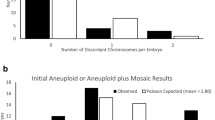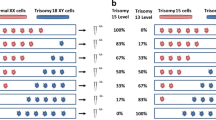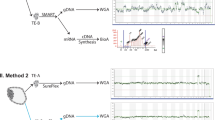Abstract
Purpose
While efforts have been made to establish blastocyst grading systems in the past decades, little research has examined the quality of biopsy specimens. This study is the first to correlate the morphology of biopsied trophectoderm (TE) cells to their quality and subsequent genetic testing results of preimplantation genetic testing (PGT), through an innovative Morphological Analysis and Genetic Integrality Criterion (MAGIC) system.
Methods
Biopsied TE cells were first evaluated according to the MAGIC procedure, followed by whole-genome amplification (WGA) and library construction, and then sequenced using the Illumina X Ten Platform. Copy number variation (CNV) and allele drop-out (ADO) rates as well as test failure rates were compared and analyzed.
Results
Our data explores the relationship between TE cell morphology and its quality and final genetic testing outcome, which is established based on the MAGIC system. MAGIC guarantees that only high- or good-quality TE cells are used for genetic testing to generate excellent data uniformity and lower ADO rates. Low-quality cells containing biopsied TE cell mass are responsible for the “background noise” of CNV analysis.
Conclusion
The MAGIC application has effectively decreased the false-positive mosaicism, hence to ensure the stability and veracity of detection results, to avoid misdiagnoses, and to improve accuracy, as well as to avoid re-biopsy procedures. The study also contributes to understand how the IVF laboratory and the molecular biology laboratory depend on each other to achieve good-quality PGT results, which are clinically relevant for the patients.





Similar content being viewed by others
Data availability
All data, code, and materials used in the analysis are available upon request.
References
Handyside AH, Kontogianni EH, Hardy K, Winston RM. Pregnancies from biopsied human preimplantation embryos sexed by Y-specific DNA amplification. Nature. 1990;344(6268):768–70.
Niederberger C, Pellicer A, Cohen J, Gardner DK, Palermo GD, O’Neill CL, et al. Forty years of IVF. Fertil Steril. 2018;110(2):185–324 e5.
Cimadomo D, Capalbo A, Ubaldi FM, Scarica C, Palagiano A, Canipari R, et al. The impact of biopsy on human embryo developmental potential during preimplantation genetic diagnosis. Biomed Res Int. 2016;2016:7193075.
Kuliev A, Rechitsky S. Preimplantation genetic testing: current challenges and future prospects. Expert Rev Mol Diagn. 2017;17(12):1071–88.
Kuliev A, Rechitsky S, Verlinsky O. Atlas of preimplantation genetic diagnosis. CRC Press; 2014.
Bradley CK, Livingstone M, Traversa MV, McArthur SJ. Impact of multiple blastocyst biopsy and vitrification-warming procedures on pregnancy outcomes. Fertil Steril. 2017;108(6):999–1006.
Neal SA, Morin SJ, Tiegs AW, Sun L, Franasiak JM, Kaser DJ, et al. Repeat biopsy for preimplantation genetic screening (PGS) reanalysis does not adversely impact obstetrical outcomes. Fertil Steril. 2018;109(3):e41.
Cimadomo D, Rienzi L, Romanelli V, Alviggi E, Levi-Setti PE, Albani E, et al. Inconclusive chromosomal assessment after blastocyst biopsy: prevalence, causative factors and outcomes after re-biopsy and re-vitrification. A multicenter experience. Hum Reprod. 2018;33(10):1839–46.
Treff NR, Marin D. The “mosaic” embryo: misconceptions and misinterpretations in preimplantation genetic testing for aneuploidy. Fertil Steril. 2021;116(5):1205–11.
Aoyama N, Kato K. Trophectoderm biopsy for preimplantation genetic test and technical tips: a review. Reprod Med Biol. 2020;19(3):222–31.
Munne S, Alikani M, Ribustello L, Colls P, Martinez-Ortiz PA, McCulloh DH, et al. Euploidy rates in donor egg cycles significantly differ between fertility centers. Hum Reprod. 2017;32(4):743–9.
Irani M, O’Neill C, Palermo GD, Xu K, Zhang C, Qin X, et al. Blastocyst development rate influences implantation and live birth rates of similarly graded euploid blastocysts. Fertil Steril. 2018;110(1):95–102 e1.
Irani M, Reichman D, Robles A, Melnick A, Davis O, Zaninovic N, et al. Morphologic grading of euploid blastocysts influences implantation and ongoing pregnancy rates. Fertil Steril. 2017;107(3):664–70.
Lundin K, Ahlstrom A. Quality control and standardization of embryo morphology scoring and viability markers. Reprod BioMed Online. 2015;31(4):459–71.
Racowsky C, Vernon M, Mayer J, Ball GD, Behr B, Pomeroy KO, et al. Standardization of grading embryo morphology. J Assist Reprod Genet. 2010;27(8):437–9.
Medicine ASIR, Embryology ESIG. Istanbul consensus workshop on embryo assessment: proceedings of an expert meeting. Reprod BioMed Online. 2011;22(6):632–46.
Balaban B, Urman B, Sertac A, Alatas C, Aksoy S, Mercan R. Blastocyst quality affects the success of blastocyst-stage embryo transfer. Fertil Steril. 2000;74(2):282–7.
Gardner DK, Lane M, Stevens J, Schlenker T, Schoolcraft WB. Blastocyst score affects implantation and pregnancy outcome: towards a single blastocyst transfer. Fertil Steril. 2000;73(6):1155–8.
Hill MJ, Richter KS, Heitmann RJ, Graham JR, Tucker MJ, DeCherney AH, et al. Trophectoderm grade predicts outcomes of single-blastocyst transfers. Fertil Steril. 2013;99(5):1283–9 e1.
Van den Abbeel E, Balaban B, Ziebe S, Lundin K, Cuesta MJ, Klein BM, et al. Association between blastocyst morphology and outcome of single-blastocyst transfer. Reprod BioMed Online. 2013;27(4):353–61.
Xiong S, Liu W, Wang J, Liu J, Gao Y, Wu L, et al. Trophectoderm biopsy protocols may impact the rate of mosaic blastocysts in cycles with pre-implantation genetic testing for aneuploidy. J Assist Reprod Genet. 2021;38(5):1153–62.
Neal SA, Franasiak JM, Forman EJ, Werner MD, Morin SJ, Tao X, et al. High relative deoxyribonucleic acid content of trophectoderm biopsy adversely affects pregnancy outcomes. Fertil Steril. 2017;107(3):731–6. e1
Marin D, Xu J, Treff NR. Preimplantation genetic testing for aneuploidy: a review of published blastocyst reanalysis concordance data. Prenat Diagn. 2021;41(5):545–53.
De Rycke M, Belva F, Goossens V, Moutou C, SenGupta SB, Traeger-Synodinos J, et al. ESHRE PGD Consortium data collection XIII: cycles from January to December 2010 with pregnancy follow-up to October 2011. Hum Reprod. 2015;30(8):1763–89.
Scott RT Jr, Upham KM, Forman EJ, Zhao T, Treff NR. Cleavage-stage biopsy significantly impairs human embryonic implantation potential while blastocyst biopsy does not: a randomized and paired clinical trial. Fertil Steril. 2013;100(3):624–30.
Acknowledgements
We would like to acknowledge the staff of the Department of Obstetrics and Gynecology in Peking University Third Hospital for assistance during the patient’s IVF-ET treatment.
Funding
This project is funded by the National Natural Science Foundation of China (82125013, 82288102) and the National Key Research and Development Program (2019YFA0801400).
Author information
Authors and Affiliations
Contributions
Ying Kuo and Xiaohui Zhu carried out the experimental work, data collection, acquisition of data, analysis of data, and preparation of the manuscript. Qianying Guo, Yuqian Wang, and Shuo Guan participated in the design and coordination of IVF-PGT experimental work. Ping Liu, Rong Li, Zhiqian Yan, Liying Yan, and Jie Qiao guided the study design, organized the discussion, and drafted the manuscript. All authors read and approved the final manuscript.
Corresponding authors
Ethics declarations
Conflict of interest
The authors declare no competing interests.
Additional information
Publisher’s note
Springer Nature remains neutral with regard to jurisdictional claims in published maps and institutional affiliations.
Ying Kuo and Xiaohui Zhu are joint first authors.
Rights and permissions
Springer Nature or its licensor (e.g. a society or other partner) holds exclusive rights to this article under a publishing agreement with the author(s) or other rightsholder(s); author self-archiving of the accepted manuscript version of this article is solely governed by the terms of such publishing agreement and applicable law.
About this article
Cite this article
Kuo, Y., Zhu, X., Guo, Q. et al. A novel embryo biopsy morphological analysis and genetic integrality criterion system significantly improves the outcome of preimplantation genetic testing. J Assist Reprod Genet 40, 2659–2668 (2023). https://doi.org/10.1007/s10815-023-02924-7
Received:
Accepted:
Published:
Issue Date:
DOI: https://doi.org/10.1007/s10815-023-02924-7








